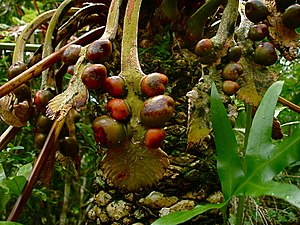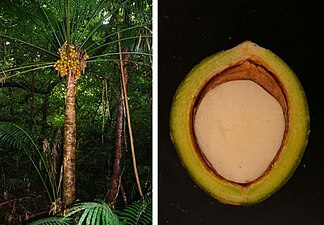Cycas micronesica
| Cycas micronesica | |
|---|---|

| |
| Scientific classification | |
| Kingdom: | Plantae |
| Clade: | Tracheophytes |
| Clade: | Gymnospermae |
| Division: | Cycadophyta |
| Class: | Cycadopsida |
| Order: | Cycadales |
| Family: | Cycadaceae |
| Genus: | Cycas |
| Species: | C. micronesica
|
| Binomial name | |
| Cycas micronesica K.D. Hill, 1994
| |
Cycas micronesica is a species of
Description
Cycas micronesica is a medium-sized tree most commonly 2–5 meters tall but can reach heights up to 15 meters. The tree has a straight palm like trunk ringed with frond scars.[7]
Leaves
Leaves are 140–180 cm long, flat in section (opposing pinnae inserted at 180 degrees on rhachis), with 130 -150 pinnae, terminated by a spine c. 4mm long; petiole usually glabrous, usually unarmed, rarely
Reproductive organs
Like all
The microsporangiate cones are pale fawn to pale orange-brown, narrowly ovoid, 30–50 cm long, 8–10 cm in diameter.
Conservation
Cycas micronesica is threatened by a combination of introduced species throughout the islands of Guam and Rota. The most notable pest is the diaspidid scale Aulacaspis yasumatsui, which was first recognized in Guam in December 2003.[10] Other threats include cycad blue butterfly (Luthrodes pandava), the longhorn beetle (Acalolepta marianarum) which causes stem damage, the alien invasive snail Satsuma mercatoria which feeds on young leaflets, and habitat loss due to the growing human population.[1] Prior to the invasion of Aulacaspis yasumatsui, it was one of the most abundant plants in Guam's forests.[11] Plant mortality was so rapid that the species was Red Listed as Endangered in 2006, only three years after the devastating invasions began.[12][13] Population counts in northwest Guam have declined from 686 individuals in early 2004 (before Aulacaspis yasumatsui reached this habitat) to 87 individuals in January 2007.[1] In 2004, Rhyzobius lophanthae was employed on Guam as a biological pest control and has lessened the population decline. However, they were ineffective on protecting cycad seedlings from Aulacaspis yasumatsui predation, as lack of seed vigor is one of the major factors contributing to C. micronesica decline.[14] without effective action against the Aulacaspis scale, it may become critically endangered. It used to have stable populations across Micronesia, with Guam having the largest. However, the Aulacaspis scale invasion caused an 87% decline in the Guam subpopulation over ten years.[15]
Threats
The Cycad Aulacaspis scale, an invasive species from Southeast Asia, poses a significant threat to Cycas micronesica, resulting in substantial plant mortality. However, it's crucial to emphasize that the current plant mortality is not solely due to this scale. The introduction of the Cycad Blue Butterfly in 2005 and the intensified damage caused by pre-existing arthropod pests are additional severe threats to the already weakened cycad population. Longhorn beetles, especially Acalolepta marianarum, are responsible for many recent plant deaths due to stem damage. Moreover, the invasive snail Satsuma mercatoria has emerged as a new and significant threat by feeding on young leaflets. This change in herbivore behavior may be a result of the compromised ability of unhealthy cycad plants to synthesize chemicals that deter herbivores. These threats collectively imperil the survival of Cycas micronesica.[15]
Gallery
-
Understory habitation
-
Pinnate leaf formation
-
Stem and palm-like structure
-
Female reproductive structures (megasporangia)
-
Male cones (microsporangia)
-
Fertilized megasporangia with developing seeds
-
Infestation by the armored scale on the male cone
-
Developed seed
See also
References
- ^ . Retrieved 22 August 2023.
- ^ Hill, K.D. (1994). Cycas micronesica. Australian Systematic Botany 7: 554-556.
- ^ Athens, J., & Ward, J. (2004). Holocene vegetation, savanna origins and human settlement of Guam. Records Of The Australian Museum, 15-30.
- ISBN 0-330-35887-1
- PMID 15809446.
- PMID 18538391.
- ^ Vogt, S., & Williams, L. (2004). Common flora & fauna of the Mariana Islands. Saipan?: S.R. Vogt & L.L. Williams.
- ^ ISSN 1446-5701.
- ^ Willis, K., & McElwain, J. C. (2014). The evolution of plants (2nd ed.). Oxford, United Kingdom; New York: Oxford University Press.
- ^ Terry, Irene; & Marler, Thomas. (2005). Paradise Lost? Tipping the scales against Guam’s Cycas micronesica. The Cycad Newsletter 28(3-4): 21-23.
- ^ Donnegan, J., & Pacific Northwest Research Station. (2004). Guam's forest resources, 2002 (Resource bulletin PNW ; 243). Portland, OR: U.S. Dept. of Agriculture, Forest Service, Pacific Northwest Research Station.
- .
- JSTOR 20700414.
- .
- ^ a b "Redlist - Cycas micronesica".
External links
- The Cycad Pages – Cycas micronesica Archived 2014-06-23 at the Wayback Machine
- Plants of Guam [Botanical]- University of Guam College of Natural Arts and Sciences
- Flickr: Plants of Guam by Lauren Gutierrez - Cycas micronesica K.D. Hill
- Guam Plant Extinction Prevention Program
"Home". Guam Plant Extinction Prevention Program. Retrieved 2018-06-08.









